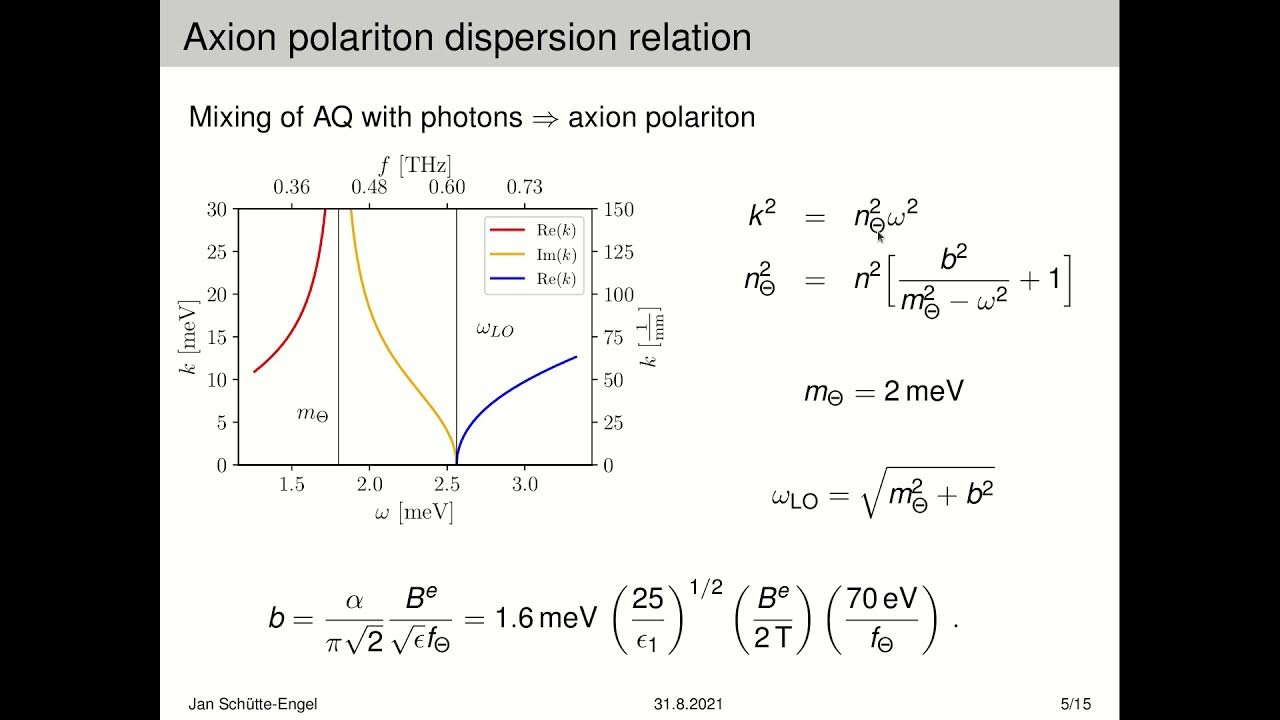Axion quasiparticles are at the forefront of research aimed at unraveling the mysteries of dark matter, a pivotal component of our universe that remains largely unobserved. These theoretical entities, posited as solutions to complex questions in particle physics, have captured the attention of leading scientists, including a team from Harvard and King’s College London. Their groundbreaking work not only offers a promising avenue to confirm the existence of axions but also paves the way for new advancements in quantum technologies. By utilizing materials like manganese bismuth telluride, the team has crafted a unique environment for these quasiparticles to reveal their elusive nature. This innovative research is not just a scientific endeavor; it represents a significant leap toward understanding the fundamental building blocks of the universe and the potential applications of these findings in the realm of particle physics and cosmology.
In the exciting realm of fundamental physics, the investigation of elusive particles known as axion quasiparticles offers a promising approach to comprehending dark matter, a mysterious and pervasive force in our cosmos. Researchers are actively pursuing these theoretical constructs as potential solutions to some of science’s most profound questions. Through creative experiments, scientists are using advanced materials like manganese bismuth telluride to facilitate the study of these quasiparticles, which could redefine our understanding of matter and energy. This interdisciplinary research combines insights from condensed-matter physics and high-energy physics, heralding a new era of exploration within quantum technologies. Harnessing the dynamics of these axion quasiparticles may unlock secrets that have long eluded scientists, shedding light on the nature of dark matter and further establishing a foundation for new scientific breakthroughs.
Understanding Axion Quasiparticles
Axion quasiparticles represent an intriguing frontier in modern physics, acting as theoretical simulations of axion particles themselves. These quasiparticles are crucial in the search for direct evidence of axions, which are proposed as a fundamental component of dark matter. In essence, an axion quasiparticle can exhibit the same properties as a true axion, allowing scientists to detect their interactions in experimental settings. This research paves the way for further studies into their behavior, helping physicists unravel the complexities of the universe’s missing mass.
The nature of axion quasiparticles provides valuable insights into the potential mechanisms of dark matter interactions. Through controlled experiments, researchers can observe the response of these quasiparticles when subjected to varying conditions. By manipulating their environments, such as temperature and magnetic fields, scientists are leveraging the unique properties of axion quasiparticles to create sensitive detectors capable of identifying elusive dark matter signals.
Key Advances in Dark Matter Research
The pursuit of discovering axions as constituents of dark matter has seen significant breakthroughs, particularly through interdisciplinary approaches that combine fields like particle physics and material science. Recent experiments led by a team from Harvard and King’s College highlight the promising potential of manganes bismuth telluride as a substrate for studying axion quasiparticles. This unique material, which possesses exceptional electronic properties, provides an ideal platform for nurturing axion-like behaviors necessary for advancing dark matter detection.
Understanding dark matter is pivotal for unfolding the universe’s mysteries, comprising approximately 85% of its total mass yet remaining undetectable by conventional means. The insights gained from studying axion quasiparticles enable researchers to develop innovative technologies aimed at uncovering dark matter’s elusive signals. This knowledge not only enhances the fundamentals of particle physics but also guides future research, as new methodologies emerge from the experimental successes.
The Role of Quantum Technologies
Quantum technologies play a pivotal role in advancing research into axion particles and their quasiparticle counterparts. The innovative approaches taken by researchers, including ultrafast laser optics and advanced measurement tools, are reshaping the landscape of experimental physics. By harnessing the subtleties of quantum states within materials such as manganese bismuth telluride, scientists are poised to push the boundaries of what can be achieved in detecting dark matter.
Through continuous development in quantum technologies, there lies a promise of unprecedented accuracy in measuring faint signals associated with dark matter interactions. The work presented by the collaboration underscores the importance of these technological advancements in creating effective detectors for axion-induced phenomena. This multi-faceted integration of quantum materials not only enhances dark matter research but also sets the stage for breakthroughs in various applications across other areas of science and technology.
Innovative Techniques in Particle Physics
The innovative techniques pioneered in this research not only elucidate the dynamics of axion quasiparticles but also encapsulate the intersection of creativity and scientific inquiry within the field of particle physics. Sophisticated methods, including precision nano-fabrication and controlled atmospheric conditions, have enabled the team to extract the hidden properties associated with these quasiparticles.
As physicists develop tools that enhance the visibility and detectability of axion quasiparticles, each advancement brings them closer to confirming their role in dark matter. The collaboration’s use of specific engineering techniques exemplifies the potential of condensed-matter physics to revolutionize our understanding of the very foundations of the universe.
Implications for Future Research
The implications of successfully observing axion quasiparticles reach far beyond mere detection of dark matter. They signal a potential shift in our comprehension of fundamental particles and cosmological phenomena. With researchers aiming for enhanced precision in their experiments, the path ahead looks promising towards not just identifying axions but also understanding their implications within the broader context of the universe.
Future research endeavors are likely to focus on refining the experimental methodologies to enable a clearer probe into axion dark matter. The team’s commitment to interdisciplinary collaboration ensures the integration of diverse perspectives, which is essential in tackling the challenges that lie ahead in particle physics. With sustained efforts, the hope within the scientific community is to uncover the truth about both axions and dark matter.
Challenges in Dark Matter Detection
Detecting dark matter remains one of the most formidable challenges faced by physicists today. The difficulty arises from the elusive nature of its proposed constituents, such as axions, which demand highly sensitive and sophisticated detection methods. This necessitates innovative material choices, such as manganese bismuth telluride, that can respond adequately to the faintest signals expected from dark matter interactions.
The research demonstrates that while significant progress has been made, numerous obstacles remain. Crafting experiments that can effectively isolate dark matter signals from the surrounding noise is a primary focus. Collaborations among the global scientific community will continue to be key in sharing knowledge and enhancing techniques needed for advancing the state of dark matter research.
Exploring Manganese Bismuth Telluride
Manganese bismuth telluride is at the forefront of material science innovations, particularly in the context of particle physics. This compound not only exhibits unique electronic and magnetic properties but has also proven to be a crucial material in the study of axion quasiparticles. Its capacity to be engineered into a two-dimensional structure allows for enhanced interaction with axions, significantly improving the capabilities of detecting potential dark matter signals.
The intricate design of these materials, including their air-sensitive characteristics and the precision required in their fabrication, highlights the challenges faced by researchers. However, these hurdles also underscore the potential for groundbreaking discoveries. By continuing to explore and manipulate manganese bismuth telluride, scientists are not only advancing theoretical knowledge but also paving the way for new technologies that could revolutionize our understanding of the universe.
The Significance of Interdisciplinary Collaboration
Interdisciplinary collaboration emerges as a vital component for the success of modern scientific inquiries, particularly in the intricate field of particle physics. The recent findings on axion quasiparticles stem from a blend of expertise across various domains, including condensed-matter physics, chemistry, and high-energy physics. This collaborative effort has yielded significant insights into potential detection methods for dark matter, showcasing how combining diverse skill sets can lead to breakthrough advancements.
In a world of complex scientific challenges, the ability to share knowledge and methodologies not only enhances experimentation but fosters innovative thinking. The research community’s commitment to collaboration stands as a model for future scientific endeavors, strengthening the potential for tackling issues that have puzzled physicists for decades. By working together, scientists can create a synergy that will continue to drive the quest for understanding the fundamental components of the universe.
Looking Ahead: The Future of Axion Research
As the hunt for axion particles continues, researchers remain optimistic about the future of axion research and its implications for understanding dark matter. The groundwork established by current experimental findings lays a solid foundation for more targeted explorations into the properties of these quasiparticles. With refined techniques and a growing array of tools at their disposal, scientists are well-equipped to push the boundaries of what is achievable in detecting dark matter.
The commitment to uncovering the mysteries of dark matter fuels the excitement within the scientific community. As new technologies and collaborative efforts unfold, the next decades could herald a new era of discovery, revealing truths that may redefine our comprehension of the universe. The potential advancements in detecting axion signals could ultimately lead to groundbreaking revelations, cementing the role of axion research in the ongoing exploration of dark matter.
Frequently Asked Questions
What are axion quasiparticles and how do they relate to dark matter?
Axion quasiparticles are theoretical constructs that simulate axion particles, which are hypothesized to make up dark matter, a mysterious substance that constitutes a significant portion of the universe’s mass. In recent research, axion quasiparticles have been used as potential detectors for actual dark matter axions, signaling a crossover between particle physics and dark matter research.
How do researchers confirm the existence of axion quasiparticles in experiments?
Researchers confirm the existence of axion quasiparticles through advanced experimental techniques, such as precision nano-fabrication of manganese bismuth telluride. By detecting the response of these quasiparticles to dark matter axions, scientists can validate theoretical predictions and explore the fundamental nature of dark matter.
What role do manganese bismuth telluride and quantum technologies play in the study of axion quasiparticles?
Manganese bismuth telluride serves as an ideal material for nurturing axion quasiparticles due to its unique electronic and magnetic properties. This material, when structured into a 2D crystal, enhances the probability of observing quasiparticles, thus aiding researchers in harnessing quantum technologies for effective dark matter detection.
What is the significance of axion quasiparticles in the context of particle physics?
Axion quasiparticles represent a major breakthrough in particle physics as they provide a method to simulate and potentially detect dark matter axions, which have been elusive in experimental settings. Their discovery could offer profound insights into the cosmos, including the composition and history of the universe.
How might axion quasiparticles lead to advancements in quantum technologies?
The study of axion quasiparticles could pave the way for new quantum technologies by exploring novel interactions between light and matter, particularly through innovations like axion polaritons. These advancements may revolutionize optical applications and enhance detection capabilities for dark matter.
What experimental techniques are used to study axion quasiparticles, and why are they challenging?
Experimental techniques such as ultrafast laser optics and precision measurement tools are employed to study axion quasiparticles. These methods are challenging due to the delicate nature of materials like manganese bismuth telluride, which require controlled environments and advanced nano-fabrication to unveil the properties of the quasiparticles effectively.
What future research directions are anticipated for axion quasiparticles and dark matter detection?
Future research will focus on refining experimental setups to enhance the detection of axion dark matter, utilizing interdisciplinary approaches from condensed-matter physics and material chemistry. The goal is to develop experiments that can directly probe for dark matter axions and potentially unlock more mysteries of the universe.
Why are axion quasiparticles considered a promising avenue for exploring dark matter?
Axion quasiparticles are considered promising because they allow researchers to simulate axion behavior and directly interact with potential dark matter signals. Their ability to act as detectors for dark matter axions could lead to significant breakthroughs in understanding the fundamental properties of dark matter.
| Key Points |
|---|
| Axions are hypothesized particles that may explain dark matter and fundamental questions in particle physics. |
| Recent experiments led by Harvard and King’s College London use quasiparticles to hunt for axions. |
| Confirmation of axions could provide insights into the universe’s history and composition. |
| Axion quasiparticles act as simulations that could detect actual axions if they exist. |
| Innovative techniques and materials (manganese bismuth telluride) were employed to create a platform for axion quasiparticles. |
| The experimental findings open avenues for developing new quantum technologies and understanding dark matter. |
| The research is a significant step forward in the search for dark matter, which constitutes a large part of the universe’s mass. |
Summary
Axion quasiparticles are at the forefront of research aimed at unraveling the mysteries of dark matter. Recent groundbreaking experiments have taken significant steps toward confirming the existence of these elusive particles, which are believed to play a vital role in our understanding of the universe. As researchers utilize advanced materials and techniques to explore axion quasiparticle properties, the potential for revolutionary discoveries in both particle physics and cosmology grows stronger. Not only could this lead to new insights into dark matter, but it also points to exciting developments in quantum technology.



